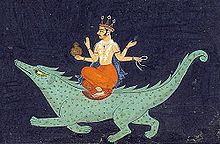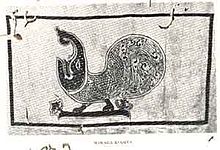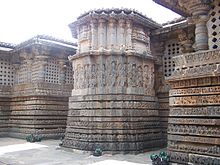- Makara (Hindu mythology)
-
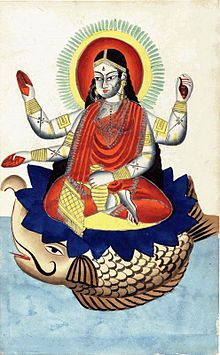 Makara as the Vahana (vehicle) of the goddess Ganga
Makara as the Vahana (vehicle) of the goddess Ganga
Makara (Sanskrit: मकर) is a sea-creature in Hindu mythology. It is generally depicted as half terrestrial animal (in the frontal part in animal forms of elephant or crocodile or stag, or deer) and in hind part as aquatic animal, in the tail part, as a fish tail or also as seal. Sometimes, even a peacock tail is depicted.
Makara is the vahana (vehicle) of the Ganga - the goddess of river Ganges (Ganga) and the sea god Varuna. It is also the insignia of the love god Kamadeva. Kamadeva’s flag (dhvaja) is known as Karkadhvaja, a flag having makara depicted on it. Makara is the astrological sign of Capricorn, one of the twelve symbols of the Zodiac. It is often portrayed protecting entryways to Hindu and Buddhist temples.
Makara symbolized in ornaments are also in popular use as wedding gifts for bridal decoration. The Hindu Preserver-god Vishnu is also shown wearing makara-shaped earrings.
Contents
Etymology
'Makara' is a Sanskrit word which means "sea dragon" or "water-monster" and in Tibetan language it is called the "chu-srin",[1] and also denotes a hybrid creature.[2] It is the origin of the word 'mugger' ( गुंडा ) in Hindi.[3] The Hindi word for Crocodile is मकर (makar, makara).[4] The English word 'mugger' evolved meaning one who sneaks up and attacks another. The name is applied to the Mugger crocodile, the most common crocodile in India, and is descriptive of its aggressive feeding behavior.[5]
Vedic depictions
During the Vedic times when Indra was the God of heaven, Varuna, the Vedic water god became the God of the seas and rode on makara, which was called “the water monster vehicle”.[6][7]
Makara has been depicted typically as half animal half fish. In many temples, the depiction is in the form of half fish or seal with head of an elephant. It is also shown in an anthropomorphic (abstract form) with head and jaws of a crocodile, an elephant trunk with scales of fish and a peacock tail. Makara is the mount of Varuna, the god of winds in Hindu mythology and also of the deity of the Ganga River. Lakshmi sitting on a lotus is also a depiction in which she pulls the tongue of the elephant shaped makara is meant to project Lakshmi’s image as the goddess of prosperity, wealth and well being.[2][5][8] It represents a chaotic state, which eventually is restored to a state of regular order.[2]
Makara is also the emblem of Kamadeva, the vedic god of love and desire. It is also known as ‘Makara-Ketu’ which means “long tailed makara.” It is the tenth sign of the Zodiac, called rasi in Sanskrit, which is equivalent to the zodiacal sign of Capricorn (goat symbol).[6]
Iconography
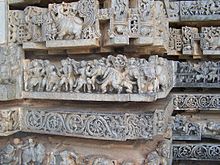 Row of Makara in base of Chennakesava Temple at Belur, Karnataka Note Makara standing vertical at corner.
Row of Makara in base of Chennakesava Temple at Belur, Karnataka Note Makara standing vertical at corner.
In Hindu iconography, Makara is represented as the vahana (‘vehicle’) of Ganga, the river goddess. A row of makara may run along the wall of a Hindu temple, or form the hand rail of a staircase.[5]
The leading Hindu temple architect and builder Ganapati Sthapati describes Makara as a mythical animal with the body of a fish, trunk of an elephant, feet of a lion, eyes of a monkey, ears of a pig, and the tail of a peacock.[5] A more succinct explanation is provided: "An ancient mythological symbol, the hybrid creature is formed from a number of animals such that collectively possess the nature of a crocodile. It has the lower jaw of a crocodile, the snout or trunk of an elephant, the tusks and ears of a wild boar, the darting eyes of a monkey, the scales and the flexible body of a fish, and the swirling tailing feathers of a peacock."[6]
Traditionally, a makara is considered to be an aquatic mythical creature. Makara has been depicted typically as half animal half fish. Some traditional accounts identify it with a crocodile, specifically Gharial because of its long extended snout. It is depicted with the forequarters of an elephant and the hindquarters as a fish tail. Crocodile was also a form which was used in the earlier days which was shown with human body.[5][9]
In many temples, the depiction is in the form of half fish or seal with head of an elephant. It is also shown with head and jaws resembling a crocodile, an elephant trunk with scales of fish and a peacock tail.[2] Other accounts identify it with Gangetic Dolphin having striking resemblances with the latter, now found mainly in Vikramshila Gangetic Dolphin Sanctuary. Others portray it as a fish body with an elephant's head. The tradition identifies the makara with water, the source of all existence and fertility.[5]
In the medieval era of South India, Makara was shown as a fifth stage of development, symbolized in the form of an elephant head and body with an elaborately foliated fish tail. Most myths maintain this symbolism of this stage in the evolution of life. [8] (Note makara in fifth row of animistic carvings in temple wall at right.)
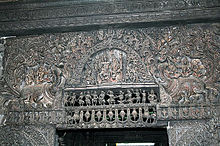 The Makara Thoranam above the door of the to Garbhagriha of Chennakesava Temple at Belur. Two makaras are shown on either end of the arch.
The Makara Thoranam above the door of the to Garbhagriha of Chennakesava Temple at Belur. Two makaras are shown on either end of the arch.
In a Hindu temple, the Makara often serves as the structural bookends of a thoranam or archway around a deity. The arch emerges up from the jaws of one Makara, rises to its peak, the Kirtimukha (the ‘Face of Glory'), and descends into the gaping jaws of another Makara. Varuna is also depicted as a white man sitting on the monster makara. As a marine monster, it is also shown with the head and legs of an antelope, and the body and tail of a fish.[10] A makara made in iron shows the monster in the form of half stag and half fish.[11] These elements are variously joined to form one of the most common recurring themes in Indian temple iconography. In Indian art, the makara finds expression in the form of many motifs, and has been portrayed in different styles. Makara figures are placed on the entry points (Toranas) of several Buddhist monuments, including the stupa of Sanchi, a world heritage site. It is found guarding the entrances to royal thrones (see Distribution below).[5]
In the Tibetan Buddhist format it evolved from the Indian form of makara. However, it is different in some ways such as, "display of lions fore paws, a horse’s mane, the gills and tendrils of a fish, and the horns of a deer or dragon. From its once simple feathered fishtail it now emerges as a complex spiraling pattern known as makara-tail design (Sanskritmakaraketu)".[6]
In Tibetan iconography, it is depicted in the Vajrayana weaponry of strength and tenacity which is the hall mark of crocodiles, since crocodiles hold on its hapless victim is nothing but death. The Vajrayan weapons which have crocodile symbolism are; axe, iron hook, curved knife, vajra, ritual dragon in all of which the theme is "emergence from the open mouth of makara".[6]
Its symbolic representation in the form of a makara head at the corner of temple roofs is as water element which also functions as a "rainwater spout or gargoyle". It is also seen as water spouts at the source of a spring. The artistic carving in stone is in the form of identical pair of makaras flanked by two nagas (snake gods) along with a crown of Garuda, which is called the kirthimukha face. Such depictions are also seen at the entrance of wooden doorways as the top arch and also as a torana behind Buddha’s images.[6]
The Newa art of Nepal uses this depiction extensively. In Newar architecture, its depiction is; "as guardian of gateways, the makara image appears on the curved prongs of the vast crossed-vajra that encompasses the four gateways of the two-dimensional mandala. Of the three dimensional-mandala this crossed-vajra supports the whole structure of the mandala palace symbolizing the immovable stability of the vajra-ground on which it stands."[6]
Makaras are also a characteristic motif of the religious Khmer architecture of the Angkor region of Cambodia which was the capital of the Khmer Empire. Makaras are usually part of the decorative carving on a lintel, tympanum, or wall. Makaras are usually depicted with another symbolic animal, such as a lion, naga or serpent, emerging from its gaping open mouth. Makara are a central design motif in the beautiful lintels of the Roluos group of temples: Preah Ko, Bakong, and Lolei. At Banteay Srei, carvings of makaras disgorging other monsters were installed on many of the buildings' corners.[12]
Ornaments
Lord Vishnu’s earrings are shown in the form of Makara.[2] Its contemporary usage is as ornaments in the form of bracelets in hollow silver ware inlaid with jewels for eyes and ears, which is given as a wedding gift to the bride. Makaras’ jaws are made of pearls which are stated to possess aphrodisiac properties [8]
Distribution
Stone sculptures of the mythological Makara and its ancient place in the iconography of Hinduism and Buddhism are widely spread throughout South Asia and Southeast Asia. Examples from ten countries are shown below:
- Makara sculptures throughout South Asia and Southeast Asia
-
Makara at Nanpaya Temple, Bagan, Burma
-
Makara on lentil from Sambor Prei Kuk temple, Kampong Thom City, Cambodia
-
Makara from Northern Qi Dynasty (CE 550-577), China
-
Makara and Kirtimukha protecting portal of Chennakesava Temple at Belur, India
-
Makara sculptures at the Candi Kalasan Temple, Indonesia
-
Makara from 7th century CE at National Museum Kuala Lumpur, Malaysia
-
Makara with Nagas, Wat Suthat, Bangkok, Thailand
-
Cham god Nāga emerging from mouth of Makara at the National Museum of Vietnamese History
Cryptozoology
Some cryptozoologists suspect the legend of the Makara may be based in fact, and associate it with the Trunko sighting on South Africa's Indian coast.[13] Some ancient sketches of Makara do tend to resemble modern illustrated renditions of the prehistoric mammal Ambulocetus.
References
- ^ Sir Monier Monier-Williams (2005), A Sanskrit-English dictionary: etymologically and philologically arranged, Motilal Banarsidass Publications, p. 771, http://books.google.com/books?id=zUezTfym7CAC&lpg=PP1&pg=PA771#v=onepage&q&f=false, retrieved 2011-1-22
- ^ a b c d e Brenda Rosen (3 March 2009). The Mythical Creatures Bible: The Definitive Guide to Legendary Beings. Sterling Publishing Company, Inc.. pp. 136–. ISBN 9781402765360. http://books.google.com/books?id=mI0vKhZXJqwC&pg=PA136. Retrieved 17 January 2011.
- ^ "Mugger", Raftar English - Hindi Dictionary, http://shabdkosh.raftaar.in/Hindi-Dictionary/Meaning/mugger, retrieved 2011-1-14
- ^ "Crocodile", Raftar English - Hindi Dictionary, http://shabdkosh.raftaar.in/Hindi-Dictionary/Meaning/crocodile, retrieved 2011-1-14
- ^ a b c d e f g Janaki Lenin (2011-1-14), "My Husband and Other Animals - The beast within File:Makara Bedur.jpg", The Hindu, ARTS » HISTORY & CULTURE (Kasturi & Sons Ltd), http://www.thehindu.com/arts/history-and-culture/article1092548.ece, retrieved 2011-1-14
- ^ a b c d e f g Robert Beer (10 September 2003). The handbook of Tibetan Buddhist symbols. Serindia Publications, Inc.. pp. 77–. ISBN 9781932476033. http://books.google.com/books?id=-3804Ud9-4IC&pg=PA77. Retrieved 17 January 2011.
- ^ George Mason Williams (2003). Handbook of Hindu mythology. ABC-CLIO. pp. 294–. ISBN 9781576071069. http://books.google.com/books?id=SzLTWow0EgwC&pg=PA294. Retrieved 17 January 2011.
- ^ a b c Archaeological Institute of America (1970). Archaeology. Archaeological Institute of America. pp. 41–43. http://books.google.com/books?id=Nt8sAAAAMAAJ. Retrieved 17 January 2011.
- ^ K. Krishna Murthy (October 1985). Mythical animals in Indian art. Abhinav Publications. pp. 37, 41, 44. ISBN 9780391032873. http://books.google.com/books?id=dMI4rZuRs1MC&pg=RA1-PA44. Retrieved 17 January 2011.
- ^ W. J. Wilkins (March 2004). Hindu Mythology, Vedic and Puranic. Kessinger Publishing. pp. 36–. ISBN 9780766188815. http://books.google.com/books?id=84pTrICjfRcC&pg=PA36. Retrieved 17 January 2011.
- ^ Wilkins (2004)", p.373
- ^ Vittorio Roveda (2005), Images of the gods: Khmer mythology in Cambodia, Thailand and Laos, River Books, p. 209 - 210
- ^ ""Trunko"", AmericanMonsters., http://64.207.147.134/monsters/carcass/index.php?detail=article&idarticle=61, retrieved 2008-12-3
- Dictionary of Hindu Lore and Legend (ISBN 0-500-51088-1) by Anna Dallapiccola
- The Illustrated Book of Signs and Symbols by Miranda Bruce-Mitford
External links
 Media related to Makara at Wikimedia Commons
Media related to Makara at Wikimedia Commons- Photo fine Makara toranam in South India
- Photos of Tibetan Buddhist Makara
- Photos of Makara toranam at Bhoologanathar - Chozhamahadevi temples in Tiruchirappalli, Tamil Nadu, South India
Hindu deities and texts Gods 
Goddesses Texts Hinduism · Hindu mythology · Indian epic poetry Categories:- Hindu legendary creatures
- Legendary reptiles
- Sanskrit words and phrases
- Tibetan Buddhist practices
- Mythical aquatic creatures
Wikimedia Foundation. 2010.

